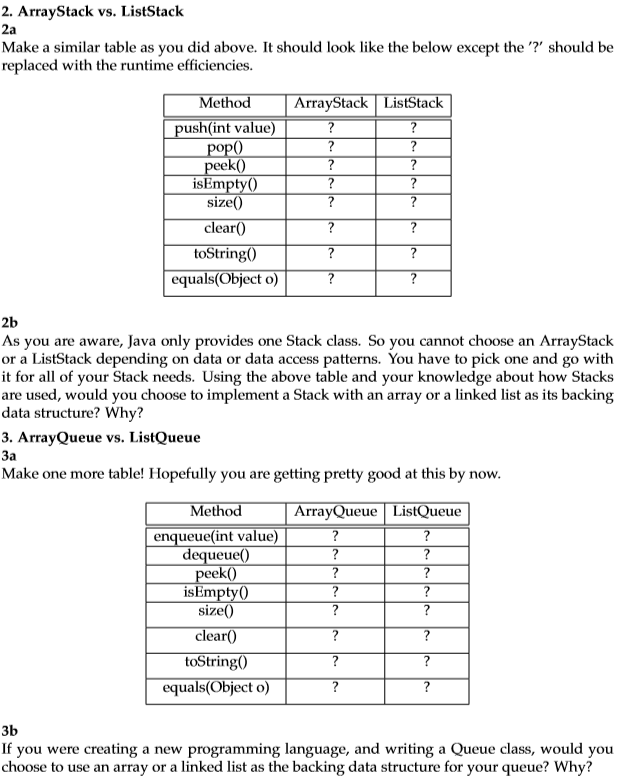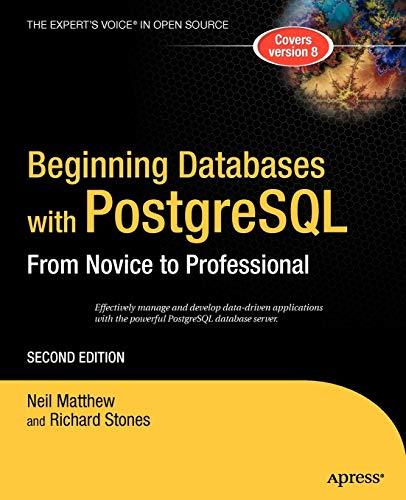Question
Write you answer please I need answer for 2a, 2b , 3a ,3b. they are writting question ArrayStack.java import java.util.Arrays; public class ArrayStack implements StackInterface
Write you answer please I need answer for 2a, 2b , 3a ,3b. they are writting question
ArrayStack.java
import java.util.Arrays; public class ArrayStack implements StackInterface { private final static int capacity = 10; private int top; private int[] stack; public ArrayStack() { this(capacity); } public ArrayStack(int initialCapacity) { top = -1; stack = new int[initialCapacity]; } public void push(int element) { if (size() == stack.length) expandCapacity(); stack[++top] = element; } private class Node { private int data; private Node next; public Node() { this(0, null); } public Node(int data, Node next) { this.data = data; this.next = next; } } private void expandCapacity() { stack = Arrays.copyOf(stack, stack.length * 2); } public int pop() { if (!isEmpty()) return -1; int result = stack[top]; top--; return result; } public int peek() { if (isEmpty()) return -1; return stack[top]; } public boolean isEmpty() { return top == -1; } public int size() { return top + 1; } @Override public void clear() { top = -1; } public String toString() { String s = ""; for(int i=size()-1;i>=0;i--){ s = s + stack[i]+" "; } return s; } } ListStack.java
public class ListStack implements StackInterface { private Node top; private int count; private int[] stack; public ListStack() { top = null; count = 0; } public ListStack(int value) { top = new Node(value, null); count = 1; } private class Node { private int data; private Node next; public Node() { this(0, null); } public Node(int data, Node next) { this.data = data; this.next = next; } } public void push(int value) { Node node = new Node(value, null); node.next = top; top = node; count++; } public int pop() { if (count == 0) return -1; Node temp = top.next; top = top.next; count--; return temp.data; } public int peek() { if (count == 0) return -1; return top.data; } @Override public int size() { return count; } @Override public boolean isEmpty() { return count == 0; } public String toString() { String str = ""; Node current = top; while (current != null) { str += current.data; if (current.next != null) { str += " "; } current = current.next; } return str; } @Override public void clear() { top = null; } } lass Queue implements QueueInterface
{
private int[] arr; // array to store queue elements
private int front; // front points to the front element in the queue
private int rear; // rear points to the last element in the queue
private int capacity; // maximum capacity of the queue
private int count; // current size of the queue
// Constructor to initialize a queue
Queue(int size)
{
arr = new int[size];
capacity = size;
front = 0;
rear = -1;
count = 0;
}
// Utility function to dequeue the front element
public void dequeue()
{
// check for queue underflow
if (isEmpty())
{
System.out.println("Underflow Program Terminated");
System.exit(1);
}
System.out.println("Removing " + arr[front]);
front = (front + 1) % capacity;
count--;
}
// Utility function to add an item to the queue
public void enqueue(int item)
{
// check for queue overflow
if (isFull())
{
System.out.println("Overflow Program Terminated");
System.exit(1);
}
System.out.println("Inserting " + item);
rear = (rear + 1) % capacity;
arr[rear] = item;
count++;
}
// Utility function to return the front element of the queue
public int peek()
{
if (isEmpty())
{
System.out.println("Underflow Program Terminated");
System.exit(1);
}
return arr[front];
}
// Utility function to return the size of the queue
public int size() {
return count;
}
// Utility function to check if the queue is empty or not
public Boolean isEmpty() {
return (size() == 0);
}
// Utility function to check if the queue is full or not
public Boolean isFull() {
return (size() == capacity);
}
}
class Main
{
public static void main (String[] args)
{
// create a queue of capacity 5
Queue q = new Queue(5);
q.enqueue(1);
q.enqueue(2);
q.enqueue(3);
System.out.println("The front element is " + q.peek());
q.dequeue();
System.out.println("The front element is " + q.peek());
System.out.println("The queue size is " + q.size());
q.dequeue();
q.dequeue();
if (q.isEmpty()) {
System.out.println("The queue is empty");
}
else {
System.out.println("The queue is not empty");
}
}
}
2. ArrayStack vs. ListStack 2a Make a similar table as you did above. It should look like the below except the '?' should be replaced with the runtime efficiencies. Method push(int value) pop() peek() isEmpty size clear() toString() equals(Object o) ArrayStack ListStack ? ? ? ? ? ? ? ? ? ? ? ? ? ? ? ? 2b As you are aware, Java only provides one Stack class. So you cannot choose an ArrayStack or a ListStack depending on data or data access patterns. You have to pick one and go with it for all of your Stack needs. Using the above table and your knowledge about how Stacks are used, would you choose to implement a Stack with an array or a linked list as its backing data structure? Why? 3. Array Queue vs. ListQueue Make one more table! Hopefully you are getting pretty good at this by now. Method enqueueint value) dequeue() peek() isEmpty size() clear() toString() equals(Objecto) Array Queue ListQueue ? ? ? ? ? ? ? ? ? ? ? ? ? ? ? ? 3b If you were creating a new programming language, and writing a Queue class, would you choose to use an array or a linked list as the backing data structure for your queue? Why? 2. ArrayStack vs. ListStack 2a Make a similar table as you did above. It should look like the below except the '?' should be replaced with the runtime efficiencies. Method push(int value) pop() peek() isEmpty size clear() toString() equals(Object o) ArrayStack ListStack ? ? ? ? ? ? ? ? ? ? ? ? ? ? ? ? 2b As you are aware, Java only provides one Stack class. So you cannot choose an ArrayStack or a ListStack depending on data or data access patterns. You have to pick one and go with it for all of your Stack needs. Using the above table and your knowledge about how Stacks are used, would you choose to implement a Stack with an array or a linked list as its backing data structure? Why? 3. Array Queue vs. ListQueue Make one more table! Hopefully you are getting pretty good at this by now. Method enqueueint value) dequeue() peek() isEmpty size() clear() toString() equals(Objecto) Array Queue ListQueue ? ? ? ? ? ? ? ? ? ? ? ? ? ? ? ? 3b If you were creating a new programming language, and writing a Queue class, would you choose to use an array or a linked list as the backing data structure for your queue? WhyStep by Step Solution
There are 3 Steps involved in it
Step: 1

Get Instant Access to Expert-Tailored Solutions
See step-by-step solutions with expert insights and AI powered tools for academic success
Step: 2

Step: 3

Ace Your Homework with AI
Get the answers you need in no time with our AI-driven, step-by-step assistance
Get Started


